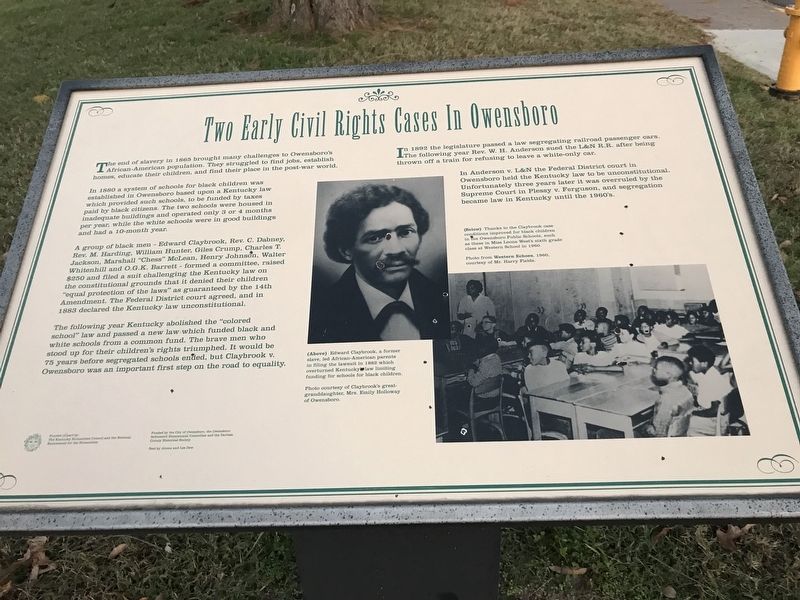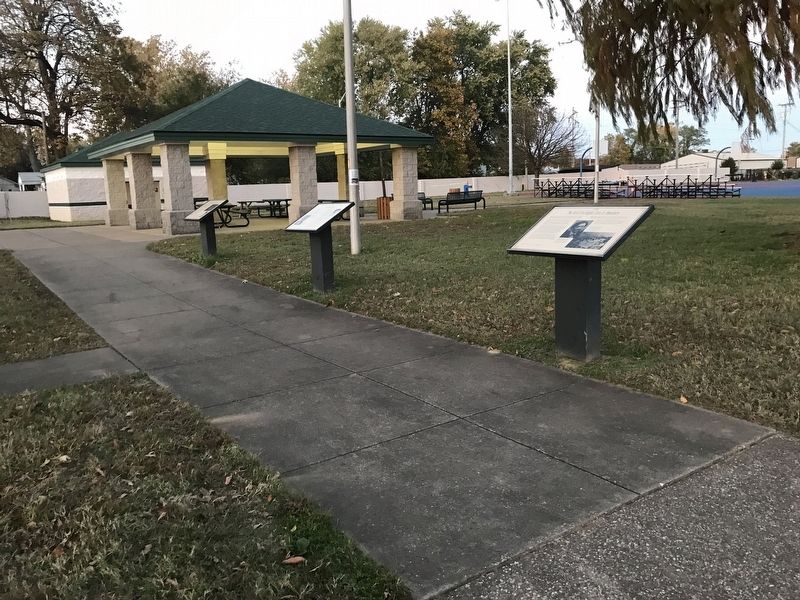Owensboro in Daviess County, Kentucky — The American South (East South Central)
Two Early Civil Rights Cases in Owensboro
Inscription.
The end of slavery in 1865 brought many challenges to Owensboro's African-American population. They struggled to find jobs, establish homes, educate their children, and find their place in the post-war world.
In 1880 a system of schools for black children was established in Owensboro based upon a Kentucky law which provided such schools, to be funded by taxes paid by black citizens. The two schools were housed in inadequate buildings and operated only 3 or 4 months per year, while the white schools were in good buildings and had a 10-month year.
A group of black men — Edward Claybrook, Rev. C. Dabney, Rev. M. Harding, William Hunter, Giles Crump, Charles T. Jackson, Marshall “Chess” McLean, Henry Johnson, Walter Whitenhill and O.G.K, Barrett — formed a committee, raised $250 and filed a suit challenging the Kentucky law on the constitutional grounds that it denied their children “equal protection of the laws” as guaranteed by the 14th Amendment. The Federal District court agreed, and in 1883 declared the Kentucky law unconstitutional.
The following year Kentucky abolished the “colored school” law and passed a new law, which funded black and white schools from a common fund. The brave men who stood up for their children's rights triumphed. It would be 75 years before segregated schools ended, but Claybrook v. Owensboro was an important first step on the road to equality.
In 1892 the legislature passed a law segregating railroad passenger cars. The following year Rev. W. H. Anderson sued the L&N R.R. after being thrown off a train for refusing to leave a white-only car.
In Anderson v. L&N the Federal District court in Owensboro held the Kentucky law to be unconstitutional. Unfortunately three years later it was overruled by the Supreme Court in Plessy v. Ferguson, and segregation became law in Kentucky until the 1960's.
Captions
Center: Edward Claybrook, a former slave, led African-American parents in filing the lawsuit in 1882 which overturned Kentucky law limiting funding for schools for black children. Photo courtesy of Claybrook's great-granddaughter, Mrs. Emily Holloway of Owensboro.
Right: Thanks to the Claybrook case conditions improved for black children in the Owensboro Public Schools, such as these in Miss Leona West's sixth grade class at Western School in 1960. Photo from Western Echoes, 1960, courtesy of Mr. Harry Fields.
Erected by City of Owensboro, Owensboro Settlement Bicentennial Committee and Daviess County Historical Society; Text by Aloma and Lee Dew.
Topics. This historical marker is listed in these topic lists:
African Americans • Civil Rights • Education • Railroads & Streetcars. A significant historical year for this entry is 1880.
Location. 37° 46.264′ N, 87° 7.415′ W. Marker is in Owensboro, Kentucky, in Daviess County. Marker can be reached from the intersection of West 5th Street and Cs-1186-30, on the right when traveling west. Marker is in Kendall-Perkins Park. Touch for map. Marker is at or near this postal address: 1200 W 5th St, Owensboro KY 42301, United States of America. Touch for directions.
Other nearby markers. At least 8 other markers are within walking distance of this marker. Born With a Purpose (here, next to this marker); Kendall-Perkins Park (here, next to this marker); The African American Community in Owensboro (a few steps from this marker); Dr. and Mrs. Clay E. Simpson, Sr. (approx. 0.2 miles away); Fourth Street Baptist Church (approx. ¼ mile away); Moneta J. Sleet, Jr. / Pulitzer Prize Winner (approx. 0.3 miles away); Old Trinity Centre Parking Area (approx. 0.4 miles away); "Stirman's Folly" (approx. half a mile away). Touch for a list and map of all markers in Owensboro.
Credits. This page was last revised on November 5, 2020. It was originally submitted on November 5, 2020, by Duane and Tracy Marsteller of Murfreesboro, Tennessee. This page has been viewed 528 times since then and 61 times this year. Photos: 1, 2. submitted on November 5, 2020, by Duane and Tracy Marsteller of Murfreesboro, Tennessee. • Devry Becker Jones was the editor who published this page.

